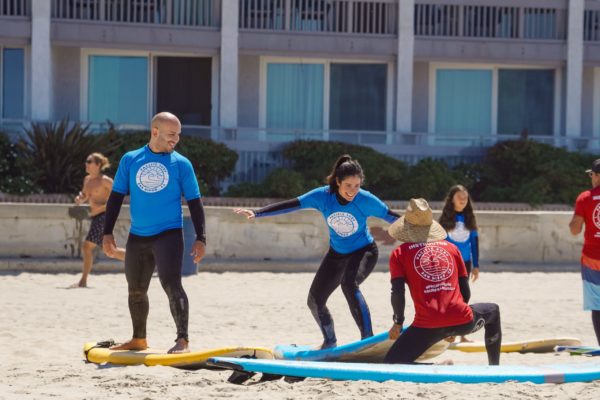Introduction to Aerial Maneuvers in Surfing
In the world of surfing, one of the most thrilling and progressive aspects is mastering aerial maneuvers. This radical style of surfing, which involves spinning and flipping in the air off of large waves, has been a significant game changer in the sport. It takes surfing to another level, adding an extra thrill that isn’t found in traditional wave riding. Many of the Surf Schools in San Diego have recognized this trend and incorporated training on aerial maneuvers into their advanced classes.
Mastering The Basics: Perfecting Your Take-off and Popping Up
Before you can start doing aerials, you first need to have a solid foundation in the basics of surfing. The first step in this process is to perfect your ‘take-off’ and ‘pop-up’ – the crucial sequences that set the stage for every successful surf. This involves sprint paddling when the wave is about to break, quickly positioning your body on the board, and then standing up in one fluid motion. This is an essential skill to master as it lays the foundation for any aerial maneuver you will perform. Our School of Surf in San Diego puts a lot of emphasis on mastering these basic moves before moving to more advanced techniques.
Required Skills: Strong Paddling and Balance
To perform aerial maneuvers, you’ll need a couple of other essential skills. First, you’ll need some seriously strong paddle power. Paddling is vital when it comes to catching the wave at its peak power, a crucial aspect of aerial surfing. The stronger you paddle, the faster you can catch the wave, which is essential when you’re planning to launch into the air. Balance is another critical skill in aerial surfing. This involves not only maintaining your balance on the board while in the air but also landing gracefully and maintaining your momentum to continue riding the wave.
The Importance Of Timing On Catching Waves
Finally, one of the most crucial aspects of performing aerial maneuvers is timing. Catching the wave at the right moment can make or break your aerial attempt. Too early, and you’ll likely end up in the trough of the wave without enough speed or height to perform your trick. Too late, and you’ll end up over the top of the wave, unable to gain control for a successful landing. This precise timing takes a lot of practice to master, but once you have, you’ll see a significant impact on your ability to perform aerial maneuvers.
Understanding surf conditions conducive for aerial maneuvers
Every surfer worth their salt knows that the quality of your wave is just as important as the quality of your surfboard when it comes to performing aerial maneuvers. You’re looking for steep waves with a powerful lip that can catapult you into the air. Becoming an expert at reading the waves and identifying the right conditions for aerial maneuvers is all part of elevating your surfing game. Additionally, consistent offshore winds are your friends, as they can offer additional lift-off, providing a stable and controllable trajectory for your aerial trick.
The key steps of executing a successful aerial maneuver
A successful aerial maneuver involves several steps, which need to be executed flawlessly and in rapid succession. The first step is finding and assessing the wave. You need a steep, powerful wave with a strong upward push. The next step is your approach – this is where you build up speed, angle your board, and prepare for the take-off. Step three is the take-off – you want to aim for the lip of the wave and push off at the right moment, propelling yourself and your board into the air. Once in the air (step four), it’s all about control – you must maintain balance, steer your board in the correct direction, and prepare for your descent. The final step (step five) is landing. A smooth landing revolves around spotting your landing spot early, even when you’re up in the air, and then managing your board and body’s impact to land with your weight evenly distributed across the board.
Common mistakes during aerial maneuvers and how to avoid them
Without a doubt, aerial maneuvers can seem daunting, particularly to beginners. One common mistake is to rush the process. Remember, you can’t rush perfection. Each step in the execution of an aerial trick should come naturally, and fluidly. Another frequent pitfall is failing to use your knees and your upper body effectively during execution. Your knees act as shock absorbers during your landing, while your upper body helps direct your movement and maintain balance in the air.
Advantages of mastering aerial maneuvers in surfing
Apart from the sheer thrill of it, mastering aerial tricks holds numerous benefits for surfers. The practice can dramatically improve your coordination, timing, and balance, all of which can benefit your overall surfing performance. Also, who can deny the competitive edge that aerials give? In competitive surfing, an expertly executed aerial maneuver can accumulate high scores and set you apart from the crowd.
Real-life Success Stories with Aerial Maneuvers
Many professional surfers can credit their victories, at least in part, to their prowess with aerial maneuvers. Julian Wilson, Italo Ferreira, and Filipe Toledo are all shining examples of surfers who’ve used their skills in the air to clinch victory in many a competition. The successes of these pro surfers underline the point that, with dedication, practice, and the right kind of support (like what we provide at our Surf School in San Diego), anyone can take their skills to the skies.
Conclusion: Transform Your Surfing with Aerial Maneuvers
Flying high above the waves, in full control of your direction and momentum, only to land smoothly, riding the wavelength to the shore is not just a dream. You’re warmly welcome at our Surf School in San Diego to learn, perfect, and master the art of fantastic, thrilling aerial maneuvers. So, why not take the plunge and let your surfing experience soar to new heights?







